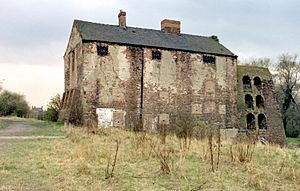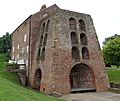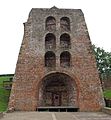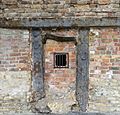Moira Furnace facts for kids
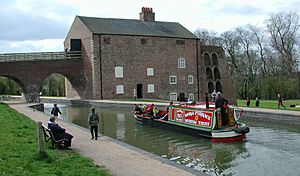
Moira Furnace is an old building from the 1800s in Moira, Leicestershire. It sits right next to the Ashby-de-la-Zouch Canal. This special place was once a huge machine called a blast furnace that made iron. The Earl of Moira had it built in 1804. Today, it's a museum where you can learn about its history. You can also see old lime kilns and craft workshops there.
Moira Furnace is a very important historical site. It is remarkably well-preserved and shows us what factories were like during the Industrial Revolution. This was a time when many new machines and ways of making things were invented.
Contents
What is Moira Furnace?
Moira Furnace was a special type of blast furnace. It used coke (a type of fuel made from coal) and a steam-engine to blow air into the furnace. This process helped melt iron ore from nearby mines. Once the iron was melted, it was used to make cast-iron items in a connected foundry.
How the Furnace Worked
The furnace you see today has three main parts:
- The blast furnace itself: This is the tall, vertical part with arches at the bottom.
- The bridgehouse: This is the large building with a sloped roof behind the furnace.
- The loading ramp: This ramp goes over the Ashby Canal.
Workers used the loading ramp to bring raw materials up to the bridgehouse. These materials included iron ore, coke, and limestone. Inside the bridgehouse, on the top floor, these materials were likely weighed and mixed. Then, they were tipped into the furnace through a hole at the top.
When the furnace was lit, a steam engine (which is no longer there) blew air into the bottom. This made the coke burn very hot, reaching temperatures of about 1,538 °C (2,800 °F). This heat was enough to melt the iron. Hot gases left through a low chimney at the top. Once the iron was melted, it was drained from the bottom of the furnace. It was then poured into molds to create pig iron, which is a basic form of iron.
Moira Furnace is one of the few blast furnaces from this time that still exists. It survived because it wasn't very successful. If it had worked well, it would likely have been rebuilt or replaced over time.
History of Moira Furnace
The Earl of Moira decided to build the furnace in 1804. He wanted to use the rich iron ore and coal found underground in his land, called Ashby Woulds. The location was perfect because it was close to the Ashby Canal for easy transport. Also, the land was low, so workers didn't have to lift heavy materials too high.
However, this was a time when furnace designs were still improving. Some parts of Moira Furnace didn't work as well as planned. It started making iron in 1806 and was used on and off until 1811. The foundry, which made cast-iron goods, kept working until after 1844. But it used iron brought in from other places.
Why the Furnace Failed
Records show that Moira Furnace had many problems. Even though it sometimes made good iron, it struggled constantly. Old documents mention issues like bad design, poor construction, low-quality raw materials, and bad management. However, some of these documents were written by people trying to avoid blame. The furnace was eventually left with its last batch of materials still inside, only partly melted.
Scientists have since studied the materials. They found a lot of sulfur in the raw materials, which might have caused problems. Also, the chimney shows signs of getting extremely hot. This suggests there was a design flaw or an issue with how it was operated.
From Failure to Museum
After the furnace stopped working, the attached foundry continued for a while. It used pig iron brought from other places. However, the foundry was torn down later in the 1800s. The bridgehouse and the engine house (a separate building) were turned into homes and survived.
By the 1970s, these buildings were falling apart. Mining underneath the area had also caused damage. The engine house was eventually demolished. Thanks to efforts from people like Philip Riden and the Leicestershire Industrial History Society, the furnace and bridgehouse were protected as an ancient monument.
North West Leicestershire District Council bought the site in 1981. They started a project to restore it and turn it into a museum and country park.
Moira Furnace Today
Today, the bridgehouse holds a museum run by the Moira Furnace Museum Trust. It's open regularly and has displays about Moira Furnace. You can learn all about the industrial history of the area.
The furnace has also become a popular spot for groups like Swadlincote Paranormal Investigations. They visit to look for paranormal activity. They even hold night-time events there that the public can join.
Gallery
See also


